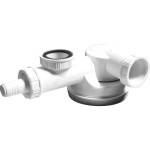Bathroom Sink Drain Height Off Floor: A Guide to Installation and Considerations
The height of a bathroom sink drain off the floor is a crucial aspect of both aesthetics and functionality in a bathroom. It affects the overall look of the sink, the ease of use, and even the plumbing system. There are several factors to consider when choosing the appropriate drain height, including the style of sink, the type of plumbing, and the intended use of the bathroom. This article will provide a comprehensive guide to understanding the ideal drain height for bathroom sinks, outlining the key considerations, common standards, and practical tips for installation.
Understanding Drain Height Standards
While there is no strict regulation for bathroom sink drain height, there are established standard ranges that are widely considered optimal for most installations. These standards aim to balance functionality, accessibility, and aesthetics.
The standard drain height for a bathroom sink is typically between 17 and 22 inches off the finished floor. This range accommodates various sink styles and ensures that the sink is both functional and aesthetically pleasing. Sinks within this range offer comfortable use for most individuals, allowing for easy access and water drainage.
Factors Influencing Sink Drain Height
Several factors influence the optimal drain height for a specific bathroom sink installation. These factors include:
1. Sink Type
The type of sink you choose greatly affects the drain height. For instance, pedestal sinks typically have a higher drain height than countertop sinks due to the pedestal base. Similarly, vessel sinks, renowned for their stylish design, often have a higher drain height, requiring a deeper countertop for installation.
2. Plumbing Considerations
The existing plumbing system and its accessibility play a significant role in determining the drain height. If the drain pipe needs to be routed through a wall, this could affect the achievable height. Access to the drain pipe for maintenance and repairs is also crucial to consider.
3. Intended Use and User Demographics
The intended use of the bathroom and the demographics of the primary users are vital factors. For example, a bathroom meant for children or seniors may require a lower drain height for accessibility. A bathroom used exclusively by an individual in a wheelchair will require a significantly lower drain height.
Choosing the Right Drain Height
When choosing the ideal drain height, it is essential to consider several factors. A higher drain height can make it easier to clean beneath the sink but may lead to more splashing when using the faucet. A lower drain height might be more comfortable for children or individuals with limited mobility but could make it harder to clean the sink area.
It is always recommended to consult a professional plumber for guidance on the appropriate drain height for your specific bathroom. They can assess the plumbing system, consider the sink type, and provide expert advice to ensure a successful and functional installation.

How To Install A Pedestal Sink W Detailed Pictures Bestlife52

What Is The Bathroom Sink Plumbing Rough In Heights

What Is The Bathroom Sink Drain Rough In Height Guide

Standard Height Of Bathroom Fittings Fantasticeng

How To Plumb A Bathroom With Multiple Plumbing Diagrams Hammerpedia

What Is Correct Rough In Height For Sink Drains Quick Answer Measuring Tips

Quick Guide To Bathroom Sink Plumbing Rough In Heights Phyxter Home Services

Standard Height Of Plumbing Fixtures Detailed Information Civil Site

Here S How Install A Bathroom Pedestal Sink

What Is The Standard Bathroom Sink Height Finest
Related Posts







